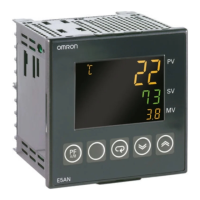69
Alarm Outputs Section 3-9
When P (Proportional Band) Is Adjusted
When I (Integral Time) Is Adjusted
When D (Derivative Time) Is Adjusted
3-9 Alarm Outputs
• Alarms can be used by the E5CN-@2@@@ (2 auxiliary outputs), E5AN/
E5EN-@1@@@ (1 auxiliary output), E5AN/E5EN-@3@@@ (3 auxiliary out-
puts), the E5CN-@1@@@U (1 auxiliary output), the E5CN-@2@@@U (2
auxiliary outputs), E5GN-@1@@@ (1 auxiliary output), and E5GN-
@2@@@ (2 auxiliary outputs).
Alarms can also be used by setting the Control Output 1 Assignment or
Control Output 2 Assignment parameter to any of the alarms from alarm 1
to 3. The alarm output condition is determined by a combination of the
alarm type, alarm value, alarm hysteresis, and the standby sequence.
For details, refer to 4-2 Alarm Hysteresis.
• This section describes the Alarm Type, Alarm Value, Upper-limit Alarm
and Lower-limit Alarm parameters.
3-9-1 Alarm Types
Increased The curve rises gradually, and a long
stabilization time is created, but over-
shooting is prevented.
Decreased Overshooting and hunting occur, but
the set value is quickly reached and the
temperature stabilizes.
Increased It takes a long time to reach the set
point.
It takes time to achieve a stable state,
but overshooting, undershooting, and
hunting are reduced.
Decreased Overshooting and undershooting occur.
Hunting occurs.
The Controller starts up faster.
Increased Overshooting, undershooting, and sta-
bilization times are reduced, but fine
hunting occurs on changes in the curve
itself.
Decreased Overshooting and undershooting
increase, and it takes time to return to
the set point.
Set
value
Set
value
Set
value
Set
value
Set
value
Set
value
Set value Alarm type Alarm output operation Description of function
When alarm value X
is positive
When alarm value X
is negative
0 Alarm function OFF Output OFF No alarm
1 (See note
1.)
Upper- and lower-limit See note 2. Set the deviation in the set point by
setting the alarm upper limit (H)
and alarm lower limit (L).
2 Upper-limit Set the upward deviation in the set
point by setting the alarm value
(X).
LH
ON
OFF
SP
X
ON
OFF
SP
ON
OFF
SP
X

